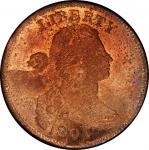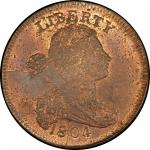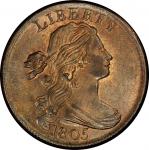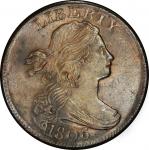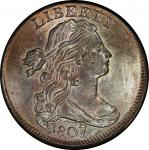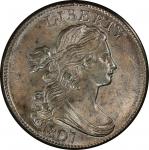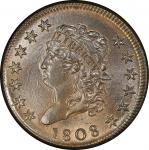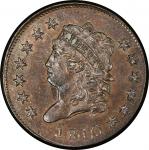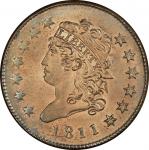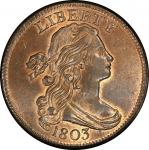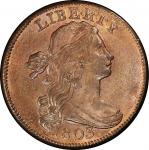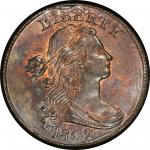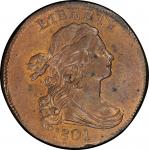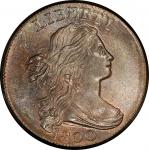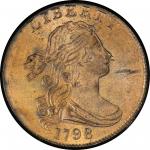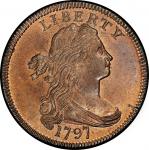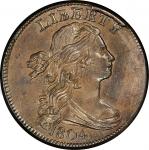1804年美分 PCGS MS 63。1804 Draped Bust Cent. Sheldon-266c. Rarity-2. Mint State-63 BN (PCGS).The 1804 cents are scarce in any condition. In fact, there are more 1799 cents advertised in a year than there are 1804, and a steady progressive rise in value can be noted. - Charles E. McGirk, "United States Cents and Die Varieties 1793-1857, Part V," The Numismatist, August 1913Rich dark chocolate brown surfaces intermingle with dark steel and olive over surfaces that exhibit good natural gloss and traces of luster. No other 1804 cent approaches this one in terms of its sharpness or Mint State status, giving this example particular importance for anyone attempting to assemble the finest possible date set of early cents. Some shallow hairlines are visible in the extreme right field, and some faint vertical hairline scratches are seen on the portrait, two on Libertys neck and a few shorter ones on her cheek, along with a longer curved one that extends from her upper lip to the curls below her ear. Aside from a tiny cluster of digs in the field off Libertys hair bow, no significant contact marks are noted.
On the reverse, some surface verdigris and scale blends in with the patina through AMERIC, with lesser proportions seen below the fraction and above TAT of STATES. A smaller area of related verdigris hides in the hair near the curl below Libertys ear. The die state is traditionally known as "Sheldon-266c," with substantial cuds over RTY of LIBERTY and MERIC of AMERICA, the last of the three main die states. Clash marks are seen at Libertys profile and throat, as well as under her hair bow. Breen describes this state as his state IV. This specimen shows the distinctive die rotation typical of this variety, with the reverse aligned roughly 45 degrees counterclockwise of proper coin turn.Over the course of this coins long history, it has been offered at auction just three times: in 1914, in 1947, and in 2009. Its provenance begins in the 19th century, when it was acquired by Philadelphian William T.W. Jester. Though listed as William T.R. Jester in the Elder sale that included his 100-coin set of cents, other sources including his death certificate and several Philadelphia city directories list him with his correct middle initials. From 1861 to 1873, Jester was listed as a dentist at 303 Carpenter Street, near the Philadelphia waterfront, but in his later years his occupation shifted to "salesman." He may have been the William Jester who served with the 199th Pennsylvania and witnessed Lees surrender at Appomattox in April 1865.
Thomas Elder reported that Jester "died on March 23, 1912, in the 80th year of his age. He was one of the old-time collectors. These cents came from the old auction sales, and from old time coin dealers and collectors, including the following: Edward Cogan, Dr. Maris, C. Randall, Dr. McBurney, and Messrs. Mason, Wood, Davis, Smith, and others."Jesters collection was an expanded date set, including all three types of 1793, both varieties of 1814, three varieties of 1817, etc. Nearly every coin was described as Uncirculated, excepting a few rare issues and a handful of cents from the 1840s that Jester may have plucked from circulation himself. Considering the sources Elder listed, many of the coins were acquired decades before Jesters death. Ed Cogans last sale was in 1879, Masons was held in June 1890, and the others were almost all out of business or deceased by 1900. Jester could have acquired this coin from any of those dealers or, given his location in the heart of large cent country, even in the wild.Even for those close to the Philadelphia Mint, obtaining an 1804 cent was far from guaranteed. James Morris was a storekeeper in Morgantown, Pennsylvania, approximately 40 miles west of Philadelphia. Morris was both a coin collector and an avid diarist, recording in 1841 that he had "put away ... a collection of cents beginning at 1793 and from thence to 1841 inclusive excepting only those of 1804 and 1815." Morris didnt know that no such thing as an 1815 cent existed, and for as rare as they were coming over his store counter, 1804 cents might as well have not existed either. Though his numismatic activities have attracted little attention, Morris diary is famous for one reason: it records the first observance of Groundhog Day known in the United States.After selling in the 1914 Jester sale, this piece disappeared down a rabbit hole of famous specialized collections. Henry Hines, the predominant auction buyer of the World War I era, purchased it from Elders auction and retained it until Dr. Sheldon acquired most of his collection during its dispersal.
Sheldon sold it for a high price to the starry-eyed principals of the Sheraton Coin Company, whose financing exceeded their numismatic skills; unable to sell the coin in the aftermath of World War II, it appears it was bought back from the 1947 ANA sale. Willard C. Blaisdell, a large cent collector who was active from the 1930s through the 1970s, acquired the piece soon thereafter. He retained it until 1975, when it was sold privately to Ted Naftzger, in whose collection it remained until the landmark sale of his early date cents in 1992.The familiar nomenclature attached to the die states of 1804 cents dates back to Charles McGirks large cent attribution guide, published serially in The Numismatist in 1913 and 1914. McGirks system forced collectors to measure spatial relationships and then check them against a columnar chart, dooming it to failure from the start. Perhaps the only relic of McGirks system is the description of 1804 cents as Sheldon-266a, Sheldon 266b, or Sheldon-266c. McGirk 1804 1A was the unbroken early die state, 1804 1B represented the scarce state with an obverse die break but no reverse die break, and 1804 1C referred to the state with breaks on both sides. McGirk was not the first to notice the fact that 1804 cents came in three die states; that discovery is credited to David Proskey in the January 1881 installment of his "Coins of the United States" in The Coin Collectors Journal, the house organ of Scott Stamp and Coin Company. Proskey, considered the most knowledgeable cent specialist of his generation, correctly noted, "The pair of dies just described were new and the only dies from which cents were struck during 1804, and owing to both breaking, they were not used in any succeeding year."
Despite a substantial reported mintage figure, it is apparent that most of the cents delivered in 1804 were dated 1803. Those dated 1804 have been recognized as rarities for a very long time.This is the only Mint State 1804 cent known. An entry at MS-62 BN on the PCGS Population report is a duplicate of this coin, dating back to the initial certification of the Naftzger early date cents on February 27, 1993. Other high grade examples include the Matthewson coin, sold in the 2016 Tom Reynolds sale as PCGS AU-53, and the French-Cardinal coin, graded AU-55 by PCGS though carried on the Condition Census at a significantly lower grade. Several other relatively high grade 1804 cents have been certified despite significant issues, including cleaning and retoning, which are perhaps overlooked more easily on this key issue than other dates. With its superb deep brown color and mostly smooth, glossy surfaces, the aesthetic appeal of this cent is excellent, even if this were not the key date of the series. As the finest known example of one of the classic keys of the most avidly collected denomination in United States numismatic history, this coin stands as a highlight even among the rarities of the D. Brent Pogue Collection.

